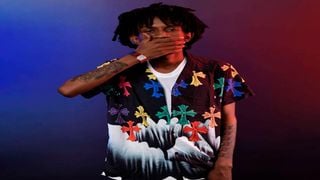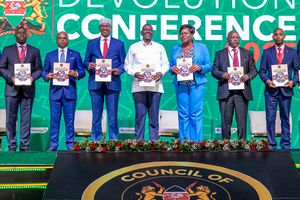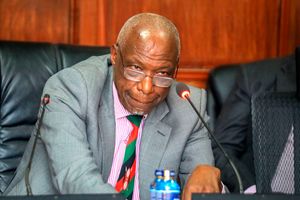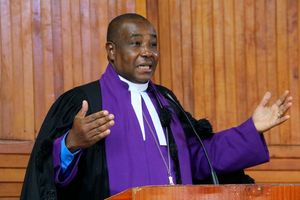
Musician Tony Kinyanjui, popularly known as Exray, who composed the song 'Sipangwingwi'.
| PoolWeekend
Premium
Of cultural planning and the new language of ‘Sipangwingi’
What you need to know:
- Historical Linguistics suggests that languages are always undergoing transformation.
- Systems that keep too tight a grip on formal, “standard” usage end up stagnating.
Matters musical, planning and the Democratic Republic of Congo (DRC) are on my mind. The main stimulants of my thoughts are the Sipangwingi craze that hit me on my recent brief visit to Nairobi, and the admission of the DRC to the East African Community. Can you read significant connections among these developments?
Singer Exray’s Sipangwingi took me back to the days of phenomenal hits like Wahu’s Sitishiki, Gidi Gidi Maji Maji’s Unbwogable and King Kaka’s Wajinga Nyinyi. These Kenyan pop blockbusters seem to have three constant characteristics in common. They are in Kiswahili/Sheng, with an inevitable linguistic innovativeness. They have a challenging “rebellious” tone to them, and they have a social dimension or significance beyond their literal statements.
Our colleague Elvis Ondieki recently gave us an enlightening account of how Sipangwingi had acquired a socio-political popularity that took its performer entirely by surprise, but also to his delight. Ondieki also commented on the linguistic gymnastics of that key refrain, “sipangwingi.” This, as you might guess, particularly caught my attention, since language change and stylistics are part of my professional practice.
My first linguistics teacher in Dar es Salaam was the late Wilfred Whiteley, author of Swahili: the Rise of a National Language. He once told us in class that the greatest advantage of Linguistics as a science was that the whole of society was one vast and constant laboratory, with a ceaseless supply of samples and specimens. Nairobi remains for me an exciting source of data for my interest in the relationship between Kiswahili and Sheng.
“Umerostinje?” I once heard, for example, a young woman ask another, as they met and greeted along Muindi Mbingu Street. Apparently, the two friends had not met in quite a while, and that was their way of saying, “Long time no see.” But you need quite a lot of decoding, or unpacking, to arrive at that interpretation.
Impact of Sheng
Literally, the phrase, or code, says, “how have you (been) lost”. It is built on the root “rosti”, from the English “lose/lost”, with the “l” slithered into an “r” in the l/r indifference characteristic of Nairobi speech, with the “i” thrown in for euphony (sweet sound). To the root is then added (affixed) the Kiswahili subject prefix U- (you) and the tense prefix -me- (present perfect). At the end is then added the suffix of the Kiswahili interrogative adverb of manner (-je), but also modified as “nje” with the “n” nasalisation common in our Central and Mount Kenya languages. The “Sheng” creation thus has contributions from Kiswahili, English and our home languages.
One could do a similar morphological analysis with sipangwingi, which is built on the Kiswahili panga (plan, programme) stem, with the relevant prefixes and suffixes to suggest, “I am not in the habit of being programmed”. In other words, “no one tells me how I should live my life”. But we should be returning to ordinary matters.
Ordinary matters, however, include the genuine concern that many Kenyans have about the growing impact of Sheng on Standard Kiswahili. One of the toughest challenges for the language teacher is how to get her or his predominantly Sheng-speaking students to express themselves in correct formal Kiswahili when the occasion demands.
My own approach to the problem starts from the realisation that the rise and growth of a language variety like Sheng is inevitable in an environment like Nairobi or Kenya’s urban areas in general. Multilingual and multicultural communities are developing in those environments, and their members are inevitably building themselves new cultural practices, including linguistic communication, to reflect their plurality. Sheng is just one manifestation of this cultural experiment.
A constructive approach to such a development would be to understand Sheng and accept it as a variety of our formal languages, especially Kiswahili. Then we can proceed and handle Sheng as just an informal register, used in some situations but not expected in others. This is what is always happening in our language use in general. The English we use in our “watering places” is not the same kind of English as we use in offices, churches or courtrooms.
Historical Linguistics suggests that languages are always undergoing transformation. Not only are languages blended to form new languages. They also change internally as expressions and constructions regarded as non-standard gradually gain acceptance into formal usage. These developments end up both enriching and invigorating the existing language systems.
Inevitable changes
Systems that keep too tight a grip on formal, “standard” usage (“usanifu” in Kiswahili) end up stagnating or descending into quaintness and archaism. Flexible ones, on the other hand, grow and expand as they absorb and incorporate the various resources of all the languages, pidgins, creoles and argots (slangs) available to them. English, with its phenomenal dominance of world communication, is a good illustration of the power of such flexibility.
As I once told an audience of Tanzanian linguists, Kiswahili will inevitably and significantly change as it takes on its envisaged continental role. I answered objectors to this with the simple statement that they could hear that my lafudhi (accent) was not quite the “standard” Kiunguja-based one, yet we were communicating without a problem. The challenge lay not in the inevitable changes in our languages but in the way we manage these changes.
Now the managemend (udhibiti) challenge is right in the middle of our linguistic room in a big way. With the admission of the DRC to the East African Community, “Uswahilini” stretches from the Indian to the Atlantic Ocean. The challenge lies not only in the huge multilingualism of the DRC but also in the kind of Kiswahili, official language, we will speak in the enlarged Jumuiya. Remember that, in addition to the other unifying languages (linguae francae) of French and Lingala, the DRC also has its own variety of Kiswahili, called “Kingwana”.
How will it relate to our variety of Kiswahili? We will have to plan for these changes. We cannot afford to remain in the “sipangwingi” zone.
Anyway, to our Ndugu Wakongomani, we say “Karibuni Jumuiya.”
Prof Bukenya is a leading East African scholar of English and literature. [email protected]





